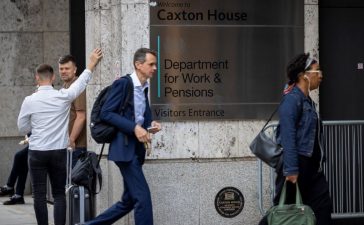As millions of US residents begin working to file insurance claims on their homes in the aftermath of Hurricanes Helene and Milton, many could be denied, particularly if their homes were damaged by flooding.
A quirk in the US home insurance market is that flood insurance is separate from typical home insurance, which usually covers wind damage from hurricanes but not flooding. Homeowners must purchase flood insurance separately if they want their homes protected against flooding.
And many don’t. In some areas where Hurricane Helene hit the hardest, less than 1% of homes had flood insurance when the storm hit. In Buncombe county in North Carolina, home to Asheville, only 0.9% of homes had flood insurance, according to data from the Insurance Information Institute.
The number of people with flood insurance in Florida, which was hit by Hurricane Milton two weeks after parts of the state were battered by Helene, is higher than in other parts of the country. But still, the take-up is low. In Sarasota county, which took a direct hit from Milton, just 23% of residents have flood insurance.
Just an inch of water can cost a home $25,000, according to the Federal Emergency Management Agency (Fema), and 99% of all counties in the US have been affected by flooding since 1996. But only about 6% of homes have flood insurance, according to the Insurance Information Institute.
Most of those with flood insurance have plans under the federal government’s National Flood Insurance Program (NFIP), created in the 60s as the private market for flood insurance was nonexistent. Though some private companies offer flood insurance, two-thirds of those with flood insurance have policies with the NFIP.
Industry experts say that many homeowners don’t know that their standard home insurance doesn’t cover floods.
“Wind damage is covered typically by your standard home insurance policy, whereas flood in general is excluded,” said Mark Friedlander, director of corporate communications at the Insurance Information Institute. “For Hurricane Helene, many people filed claims with their property insurance. Those claims most likely will be denied because it is clearly a flood damage, not a wind damage loss.”
Friedlander also said people can underestimate the flood risk for their property and choose to forgo the extra insurance to save money.
Unlike home insurance, which is required of all homeowners with federally backed mortgages, only those in Fema-designated high-risk flood zones with mortgages are required to buy flood insurance.
The high-risk flood zones are primarily areas where residents have to evacuate should a major storm happen – but it’s not just these zones that flood. Four out of 10 NFIP flood insurance claims come from outside high-risk flood zones, according to Fema.
“If it rains at your home, it could flood at your home,” Friedlander said.
Some countries, like Spain and France, include flooding coverage in standard home insurance, said Carolyn Kousky, associate vice-president for economic and policy at the Environmental Defense Fund, something that would be complicated in the US.
“We have some high-risk people who are low-income and would benefit from a flat fee,” Kousky said. “We also have areas like Miami where there are very high-income people who are at risk, and the flat fee would sort of subsidize them.”
During Hurricane Ian, which wrecked the west coast of Florida in September 2022, the cost of repairing flooding damage took up about a quarter of all uninsured loss. Uninsured flood loss was estimated to be between $10bn and $17bn, while overall uninsured loss was between $41bn to $70bn, according to CoreLogic.
Even after Hurricane Ian, the number of people who purchased flood insurance in Florida jumped just 1%, from 19% to 20% of homeowners in the state, Friedlander said.
In Florida, flood insurance can mean at least an additional several hundred dollars a year, and residents in the state are already giving up home insurance altogether because of soaring premiums.
About 15% to 20% of Florida homeowners didn’t have home insurance in 2023, more than the 12% national average, according to the Insurance Information institute.
Though home insurance premiums have gone up 52% since 2020 nationally, some places in Florida have seen increases of at least 80% during the same period, according to ICE Mortgage Monitor. Earlier this year, Florida’s office of insurance regulation reported that the average annual premium rate was about $3,600 – the national average is $1,915. In some areas of the state, like the Florida Keys, average annual premiums are closer to $7,000.
Many national insurance companies have stopped offering new policies in the state or have left it completely, leaving residents to buy plans with regional or local insurance companies that are at higher risk for insolvency. Since 2003, 41 Florida insurance companies have declared bankruptcy or have failed, according to Reuters – more than the number of companies who went insolvent in the rest of the country during the same period.
Parintha Sastry, who studied the insurance fallout after Hurricane Irma hit Florida in 2017, said that smaller insurance companies were more likely to leave policyholders with uninsured claims.
“In the places where people were relying on insurers that experienced financial distress, we see that insurance companies were not paying out claims or were not paying enough,” Sastry said. People “thought they were insured, but their insurance was not as reliable as they thought”.
The number of policies taken out through Citizens Property Insurance, the state’s government-run insurance company, has soared over the last few years. Citizens Insurance is meant to provide insurance to homeowners who aren’t able to get coverage through private insurance providers or who are given rates that are at least 20% more than a comparable policy at Citizens.
In 2019, Citizens Insurance had just over 420,000 policies. Over the next five years, the number of policies with the company would balloon to 1.4m in 2023. Over the last year, the company has been trying to offload policies back into the private sector after the state passed reforms to strengthen the market.
It’s unclear whether private insurance companies will fully re-enter Florida’s insurance market. National insurance companies say that the risk of insuring people in the state is too high given its exposure to hurricanes, along with rising construction costs and high litigation against insurance companies. In 2023, Farmers Insurance became the first major insurance company to leave the state.
It’s a dilemma that is being seen in places across the country that are facing severe weather events linked to the climate crisis. Growing risks related to climate disasters are making it costlier to live in certain places. Major insurance companies have also pulled out of parts of California that are prone to wildfires, leaving residents vulnerable to hundreds of thousands of dollars in costs if their home is destroyed.
The climate risk non-profit First Street Foundation has estimated flood risk has distorted the housing market to the tune of at least $121bn – making some homes seem more valuable than they are because flood risk is unaccounted for.
“We’re in an environment of ever-increasing risk,” Kousky said. “It’s very hard for people to get their heads around that.”









